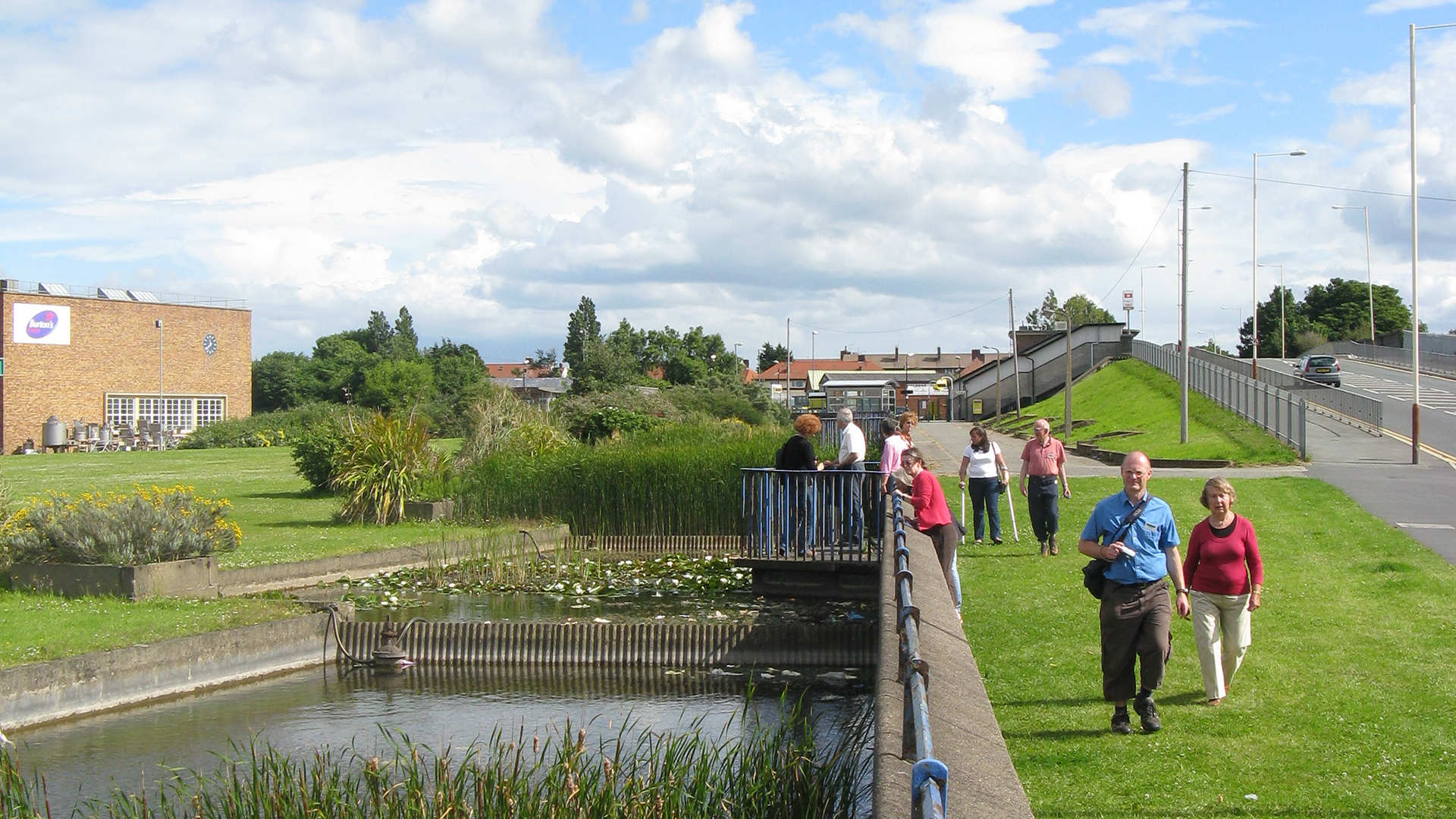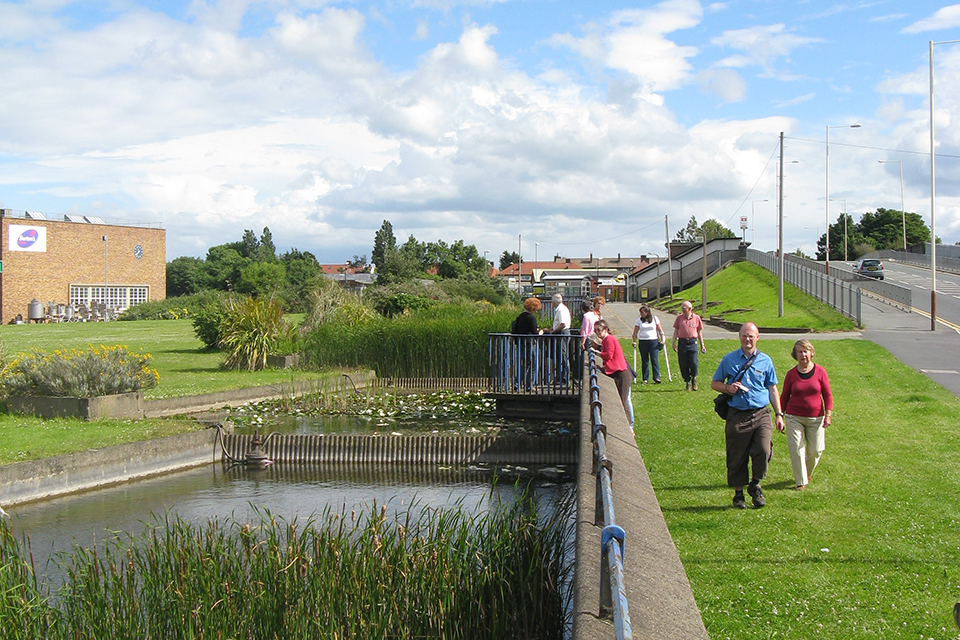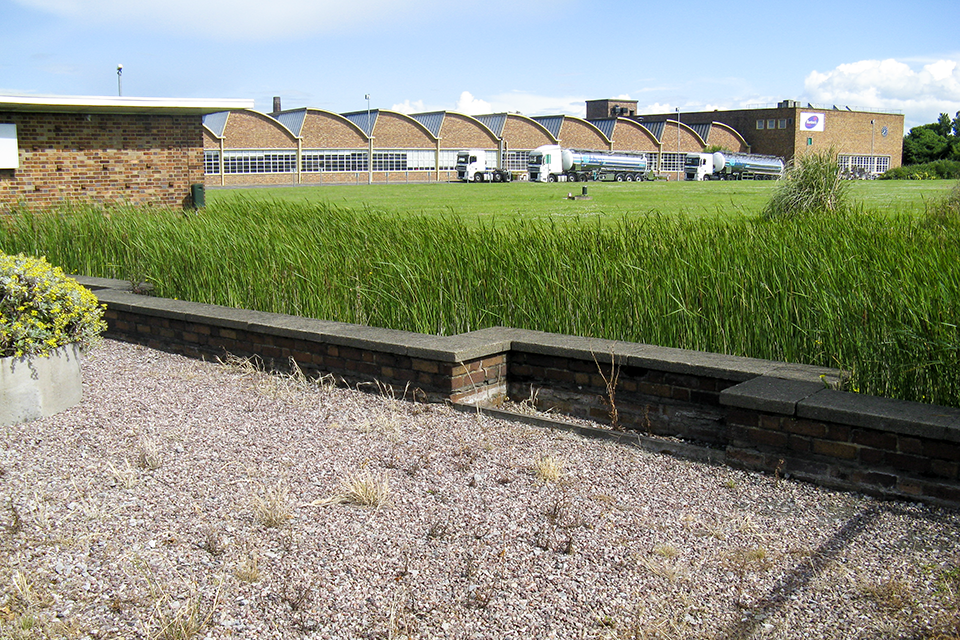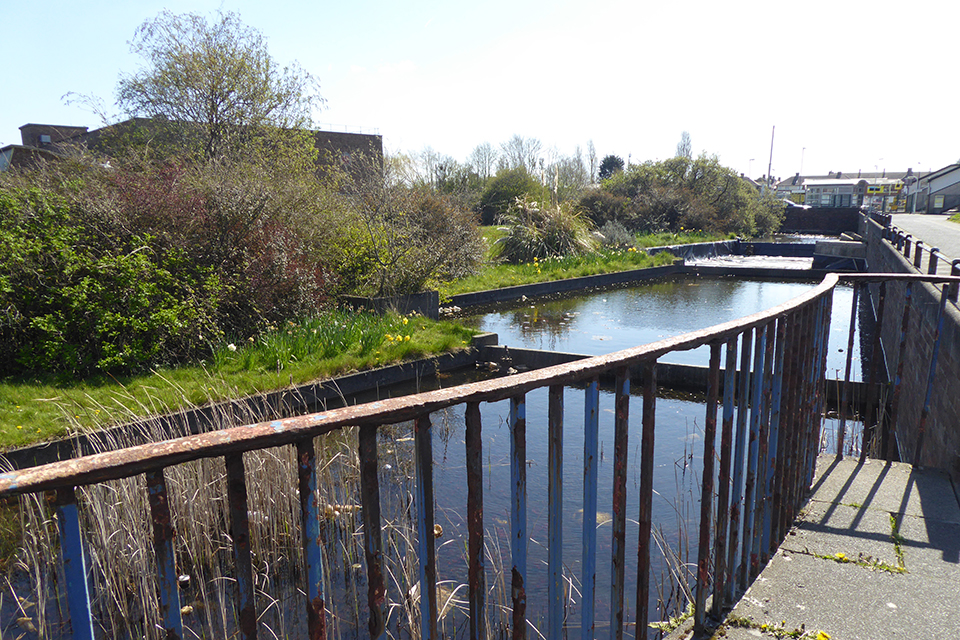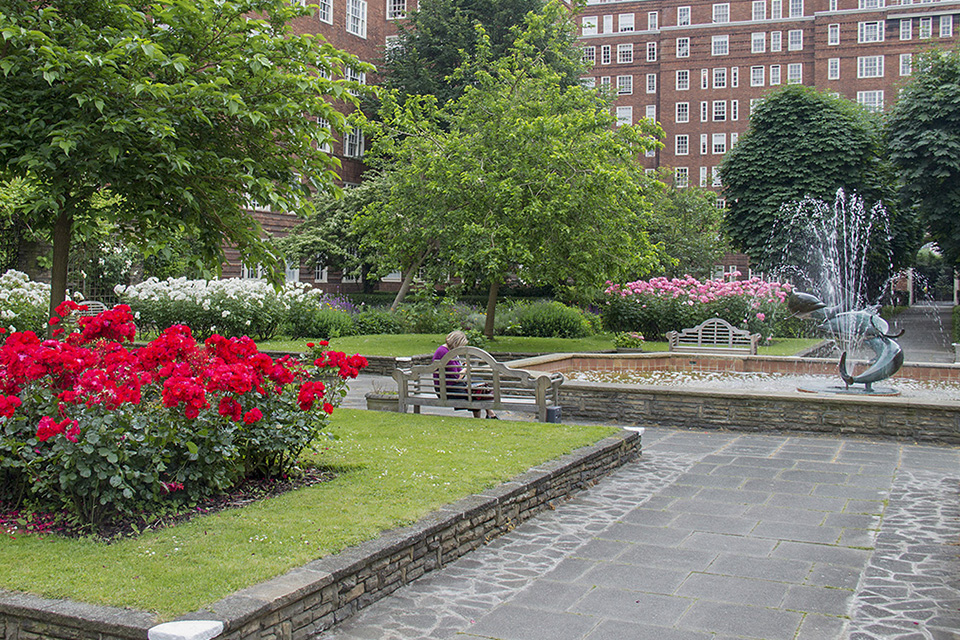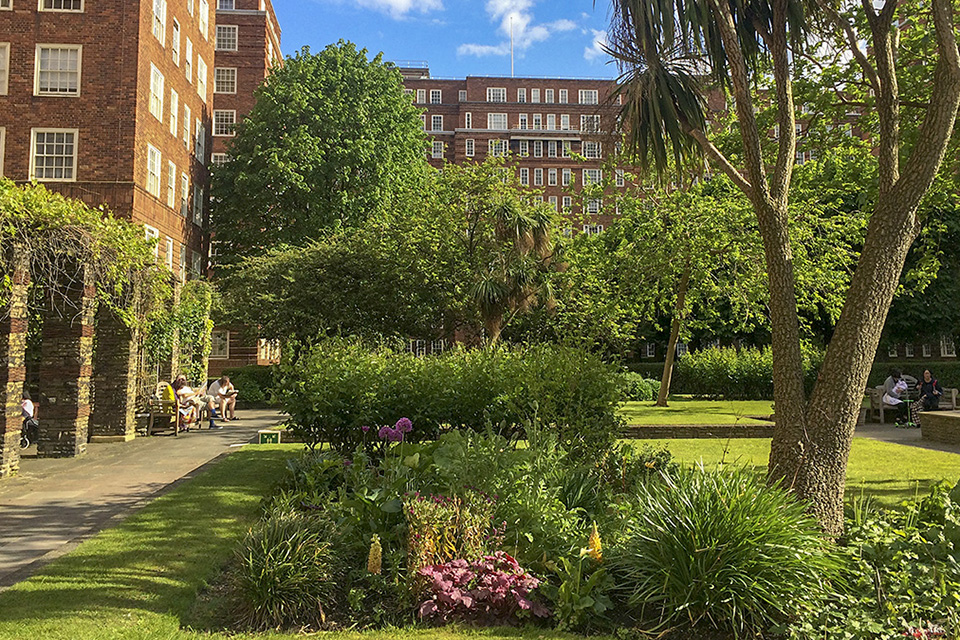In the United Kingdom, as in the United States, many postwar Modernist landscapes have been, and continue to be, at risk, their importance unrecognized. The two sites that follow, designed by Sir Geoffrey Jellicoe and Richard Sudell, are both of national significance, and have been placed on the National Heritage List for England (NHLE) within the past five years. Yet for some time their fates were worryingly uncertain.
Jellicoe (1900-1996) was born in Chelsea, London, and raised in the coastal town of Rustington, England. He attended the British School at Rome and helped establish the Institute of Landscape Architects (now Landscape Institute) – a Royal Chartered organization similar to the American Society of Landscape Architects – in 1929. He was a landscape architect as well as a prolific writer and theorist, authoring more than a dozen publications. Jellicoe was knighted in 1979 and awarded the ASLA Medal in 1981; he is considered one of the most influential landscape designers of the last half of the twentieth century.
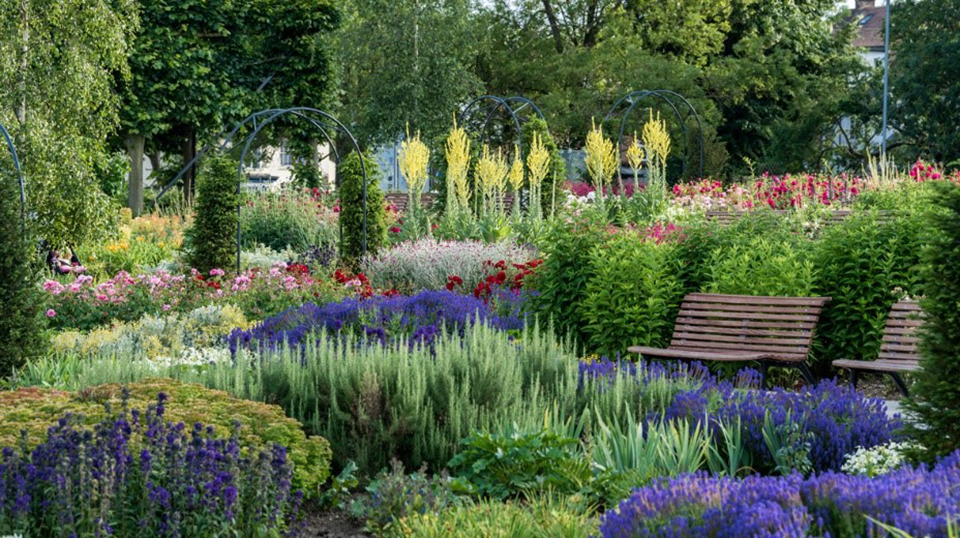 Sir Geoffrey Jellicoe’s Water Gardens after restoration, Hemel Hempstead, U.K., 2018. Photo courtesy of HTA Design.
Sir Geoffrey Jellicoe’s Water Gardens after restoration, Hemel Hempstead, U.K., 2018. Photo courtesy of HTA Design.
Sudell (1892-1968) was a contemporary of Jellicoe’s and also played an instrumental role in founding the Institute of Landscape Architects. He was born near Preston in Lancashire, northern England, and left home at the age of fourteen to apprentice as a gardener, also earning certifications in botany, chemistry, and geology. He worked as a gardener at the Royal Botanic Gardens, Kew, but then established his own practice in 1919 as a horticultural consultant. His focus was on gardens, and like Jellicoe, he was a prolific author, writing for a popular audience. Unlike Jellicoe, however, Sudell was, as Michael Gilson calls him in a 2019 article for Garden History, “the forgotten man of early twentieth-century garden and landscape history.” Or as Annabel Downs writes of him in the Oxford Dictionary of National Biography: “only a few of his contemporaries recognized the quality of his skills as a designer,” and very few understood the “significance of his publications.”
TCLF staunchly supported the advocacy of individuals and groups in the U.K., bringing visibility to the at-risk status of Jellicoe Gardens (The Cadbury Factory) and Dolphin Square Gardens to a greater American public and reinforcing their significance. With both sites, sharing their rich histories and significance with the British public, the sites’ stewards, and public officials were vitally important to saving them.
The Cadbury Factory at Moreton, designed by Jellicoe in 1952 and completed in 1954, was developed within the United Kingdom’s postwar reconstruction era. As a chocolate and biscuit (cookie) factory, it was conceived as a means of moving from wartime to peacetime production in a Modernist idiom – a rarity in its day. As landscape architect Ed Bennis wrote, “The factory appears as a testing ground for Jellicoe’s later work, particularly in his use of water, perspective and the role of the subconscious.”
Background
Located a few hundred meters from the Irish Sea on the northwest coast of England, the Cadbury Bros. Ltd. Factory (now Burton Foods) is near both Birkenhead and Liverpool. During World War II, the area suffered the greatest level of enemy bombing outside of London and experienced severe unemployment. It was recognized that building a factory on the site would be an asset in the reconstruction of the region. Its location was chosen by Cadbury since it was a few degrees cooler compared to its main factory near Birmingham, allowing them to refine chocolate year-round. Originally designed to employ 450 men and women, it employed more than 6,000 at its peak.
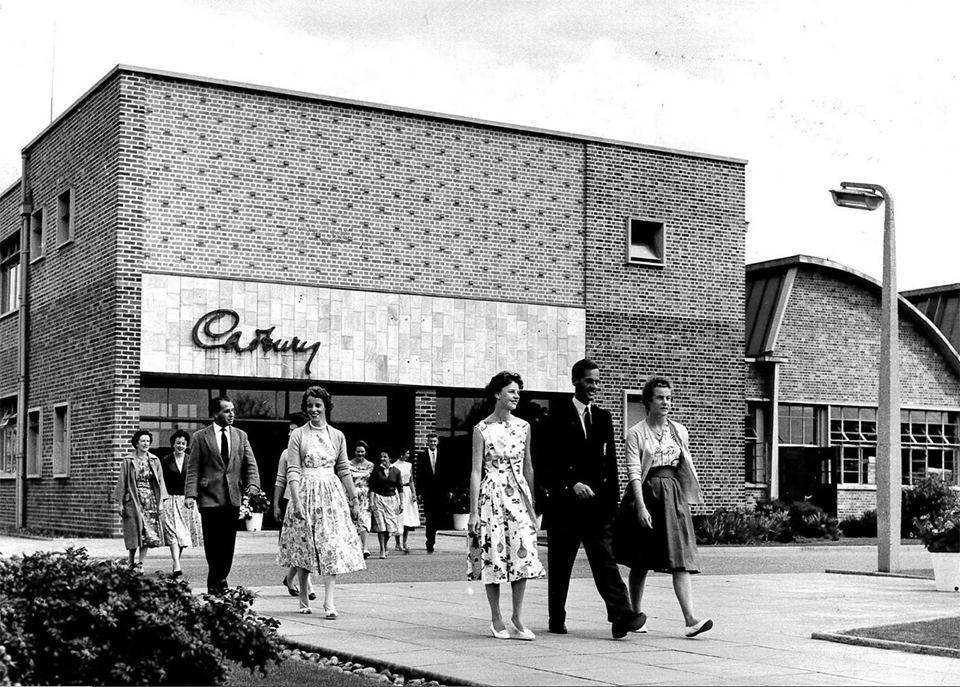 Workers outside Cadbury Factory, Moreton, Wirral, U.K., 1961. Photo courtesy Liverpool ECHO.
Workers outside Cadbury Factory, Moreton, Wirral, U.K., 1961. Photo courtesy Liverpool ECHO.
In developing the landscape, the site could hardly have been worse, since it was poorly drained and hammered by strong winds off the sea. Jellicoe wrote in 1963, when he returned to extend the complex: “From the point of view of landscape it is a diabolical site. It is bare and exposed to the most violent winds. There is a major drain, now a canal, of great width and depth cutting the site in half.” In the same report, he described how he attempted to humanize the landscape by breaking it into smaller geometric units that could be used for factory extensions, playing fields, or housing. He used the building positions and new tree plantings to provide shelter and spatial definition. The excavated spoil was used to create a mound with the new trees running along the entire east-west axis, to the north side of the new factory buildings.
At this time, a developing Jellicoe trademark was his use of metaphor; he believed in supplying interesting titles to his landscape features as a means of stimulating the imagination. At Moreton, he developed a storyline where the mounds took on the “extended shape of two serpents”; he referred to this as a clue to his design, where nature provided the artistic inspiration. The serpent was also a reference to the “vast prehistoric monsters” that would have inhabited the submerged forest that once existed on site. He used the same symbolism of the serpent for the water canal at Hemel Hempstead; in this case the serpent was seen as the guardian of the environment. The metaphor continued into the planting, where the windward side of the mounds would be “armour-plated with tough hardwood or conifer trees, whereas the inside face (being the soft under-belly) would be richly planted with flowering trees and shrubs.” Jellicoe’s use of metaphor is not contemporary with the project but was overlaid approximately a decade after the project was completed.
As part of his design Jellicoe located ten pools with nine cascades and four balconies parallel to the main road of the factory – interestingly, not at the main entrance, but instead along the route that workers using the nearby train station would take. Jellicoe wrote that “the modern water barrier corresponds to the eighteenth century ha-ha, for its purpose is to provide a fence which, though not invisible itself, nevertheless conceals its true purpose…its intention is not to keep out the determined attack but rather the casual.” This appears to be his first use of cascades, which – along with the use of water in general – would become a major feature of his later work. Moreton is pivotal in the development of Jellicoe’s thinking. It is also a rarity in terms of Modernist landscapes within the United Kingdom; few exist, as most postwar reconstruction looked backwards rather than forwards, desiring a sense of safety in the past rather than embracing an unknown future.
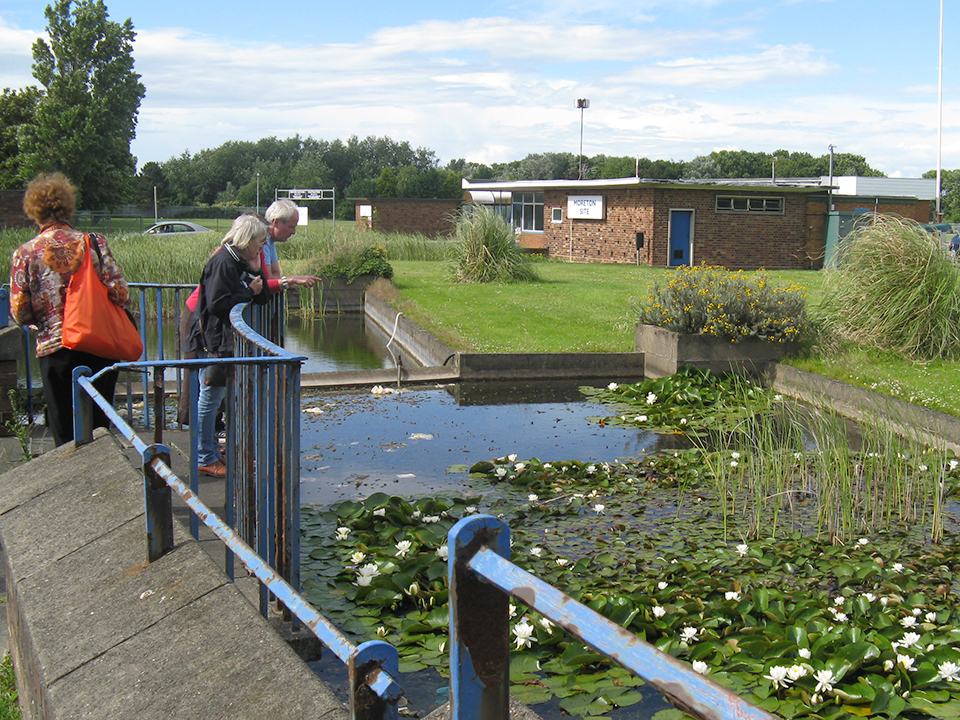 View of “modern water barrier” at Jellicoe Gardens, Moreton, Wirral, U.K., 2008. Photo by Charles A. Birnbaum, courtesy The Cultural Landscape Foundation.
View of “modern water barrier” at Jellicoe Gardens, Moreton, Wirral, U.K., 2008. Photo by Charles A. Birnbaum, courtesy The Cultural Landscape Foundation.
The Cadbury Factory was taken over by Burton’s in 1986, and the company closed the main part of the factory in 2011. Even before this closure, the landscape was in a state of neglect: it appeared that the stewards of the site had little knowledge of the importance and rarity of the work. The ponds were leaking, and the pumps had stopped, leading to clogging of the lower pools with bulrushes and weeds.
Thankfully, the Landscape Institute had been given four drawings of the site from Jellicoe, and as a result of this knowledge the landscape could be restored and its mechanical systems rehabilitated. The factory had a substantial amount of undeveloped land, including the area between the ponds and the main factory; there were development proposals for the site that could eventually result in the loss of the original fabric.
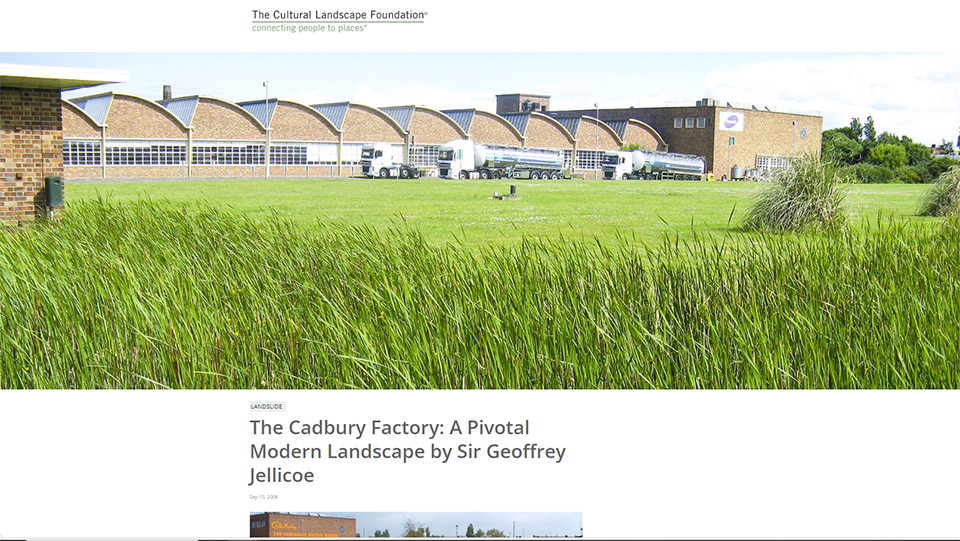
Landslide announcement for the Cadbury Factory, 2008. Image courtesy The Cultural Landscape Foundation.
Advocacy and Engagement for Jellicoe Gardens
On September 15, 2008, facing an uncertain future, TCLF enrolled the site in its Landslide program of at-risk landscapes. TCLF supported the advocacy of the Gardens Trust and other individuals and groups that placed Jellicoe’s sites in the public eye with symposia, site visits, published research, and behind-the-scenes lobbying. Jellicoe’s water gardens at Hemel Hempstead were added to the Register of Parks and Gardens of Special Historic Interest in England, part of the National Heritage List for England, in 2010; it subsequently attracted Heritage Lottery Funding and was meticulously restored to its former glory by HTA Design, a collaborative design studio based in London, in 2017.
In 2016 initial planning permission was granted for a housing development on the site of the western factory buildings in Moreton, and an application for full planning permission was submitted in August 2019. The proposed scheme retained the access road and the immediate landscape associated with the Jellicoe watercourse as part of the landscape design between the new residential structures and the main road.
On August 21, 2020, Historic England announced that the Jellicoe watercourse was one of twenty postwar landscapes that had been granted protection and added to the National Heritage List for England. According to the designation, the site’s “innovative design incorporates a series of weirs/cascades on a site with very flat topography and makes clever use of false perspectives to give the illusion of distance and mystery, as well as design tricks to draw the eye to views.” The Grade II registration and listing offers some protection as it ensures that the Gardens Trust has influence as a statutory consulting party at the planning stage. However, with the new contiguous development progressing, Jellicoe Gardens survives as a solitary and iconic landscape feature from Jellicoe’s original design.
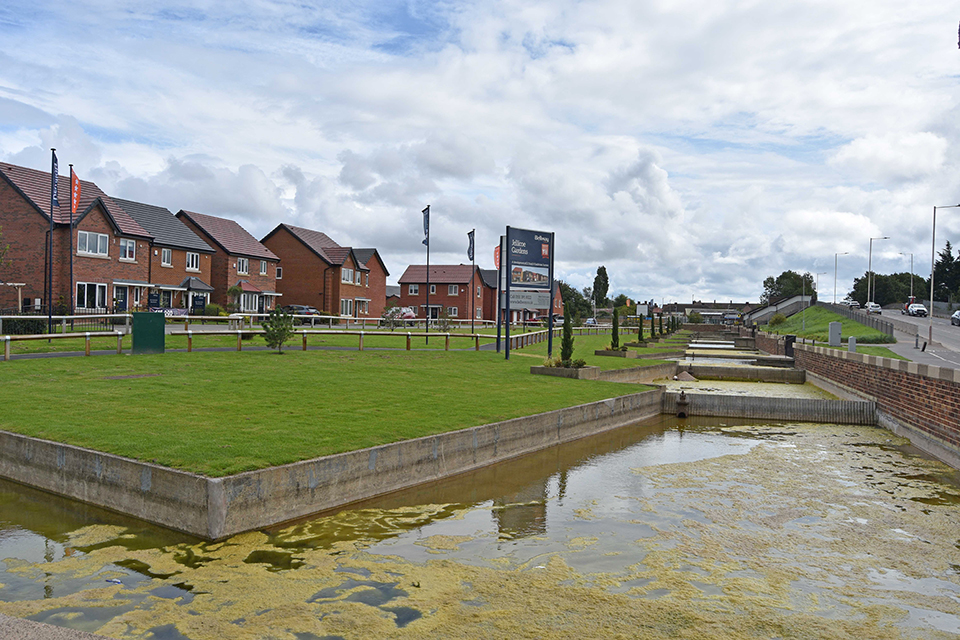 Jellicoe Gardens, Moreton, Wirral, U.K., 2023. Photo by Annabel Downs, courtesy The Cultural Landscape Foundation.
Jellicoe Gardens, Moreton, Wirral, U.K., 2023. Photo by Annabel Downs, courtesy The Cultural Landscape Foundation.
According to landscape and garden designer Annabel Downs, who helped catalogue Jellicoe’s drawings at the Landscape Institute and who is a tireless advocate for Jellicoe Gardens, Friends of the Landscape Archive at Reading (FOLAR) is in preliminary talks with the Gardens Trust about establishing a friends’ group to educate and engage the new residents about the design and designer and to encourage them to hold it in higher regard. As Downs urged in a featured interview with TCLF, “Don’t take anything around you for granted. Fall in love with places, cherish them, and raise their profile. When they are threatened, fight with everything you can muster so everyone knows what really is at stake.”
Located beside the Thames River in the Pimlico area of central London, the Dolphin Square apartment complex was built by the U.K. construction firm Richard Costain & Sons, Ltd., in 1935 and designed by architect Gordon Jeeves. The ten-story, brick-faced building comprises more than 1,200 apartments that enclose a 2.5-acre courtyard designed by the influential landscape architect, author, and horticulturalist Richard Sudell in 1936 and completed in 1938. Significantly, the gardens represent one of Sudell’s few surviving designs. It is also one of a small number of intact, large-scale landscapes designed for private housing projects in London during the interwar period.
Background
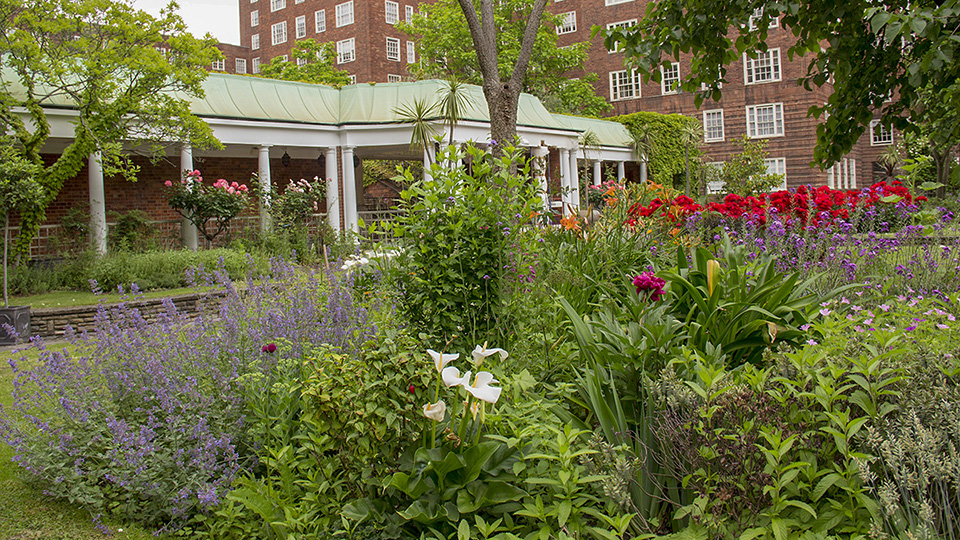 Dolphin Square Gardens, London, U.K., 2018. Photo by Beth Russell, courtesy The Cultural Landscape Foundation.
Dolphin Square Gardens, London, U.K., 2018. Photo by Beth Russell, courtesy The Cultural Landscape Foundation.
Much of the courtyard is technically a roof garden constructed atop a basement garage. It is entered from Grosvenor Road to the south, via three arches, while two vaulted passages give access from Chichester Street to the north. The courtyard comprises three primary landscapes, each formally designed with a different character and function and arranged in sequence along a central north-south axis. At the south, a large, open lawn is framed by a privet hedge and evenly divided by a wide, axial pathway lined with horse chestnuts. The pathway leads north to the Fountain Garden, the second formal space in the sequence, which contains four raised lawns and rose beds outlined by paving, all arranged around a central pool and fountain. This gives way, farther north, to a raised loggia fronted by Doric columns; within the loggia a flight of stairs leads to a terra cotta-paved garden with Spanish and Mexican inspired design elements atop the roof of the complex’s gymnasium and spa facilities (possibly the first major residential roof garden designed in London).
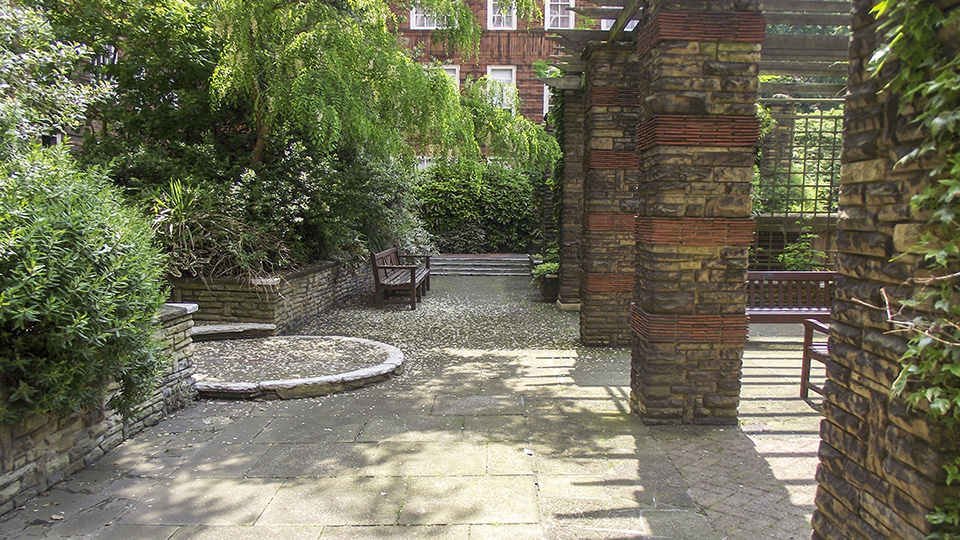 Steps and columns in Dolphin Square Gardens, London, U.K., 2018. Photo by Annabel Downs, courtesy The Cultural Landscape Foundation.
Steps and columns in Dolphin Square Gardens, London, U.K., 2018. Photo by Annabel Downs, courtesy The Cultural Landscape Foundation.
Along the eastern and western perimeter of the interior courtyard are five pairs of bays formed by the projecting spurs of the building. The central pair of bays contains pergolas and seating, with screens designed to hide the car park vents; the others contain ornamental gardens, following Dutch, Italian, Japanese, and Old English traditions. Sudell’s plantings throughout the courtyard were designed to blossom as the seasons progressed. Thousands of daffodils and tulips were planted, as well as pansies, polyanthus, primroses, crocuses, and snowdrops. A variety of paving patterns and styles are used throughout the site, designed to enhance the distinctiveness of each garden area, with one arrangement unobtrusively transitioning into another. A variety of large, ornamental concrete pots are placed atop plinths, in walled recesses, and on steps throughout, announcing entrances and further defining spaces.
Within three years of completion, the buildings and gardens of Dolphin Square sustained wartime bombing: approximately seventeen high-explosive bombs fell on or close to the site during the London Blitz, with at least one direct hit to the Fountain Garden and another to one of the blocks adjacent to the south lawn. The damaged parts of the garden were restored to the original design, subject to the availability of materials. Unfortunately, there are no surviving plans of Sudell’s design, only historic photographs of the as-built work and written accounts. The original central fountain was replaced in 1987 by a bronze dolphin sculpture by James Butler to commemorate the 50th anniversary of the square. The Spanish Garden was redesigned circa 2000 but retained much of its original character.
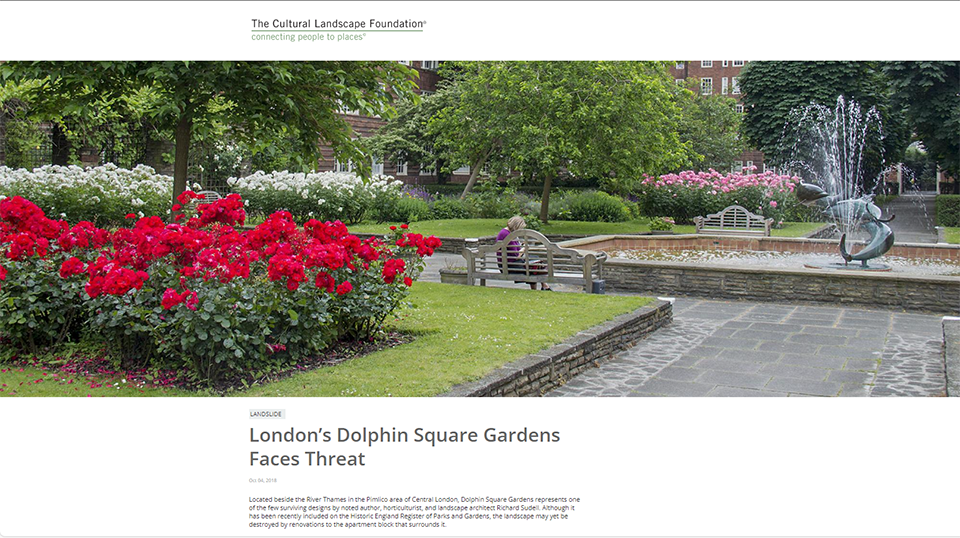
Landslide announcement for Dolphin Square Gardens, 2018. Image courtesy The Cultural Landscape Foundation.
Advocacy and Engagement for Dolphin Square Gardens
As with Cadbury, Dolphin Square Gardens was listed as Grade II on the National Heritage List for England in June 2018, indicating that the landscape is of “special interest” as an historic resource. Despite this recognition, the site faced destruction by the proposed plans of U.S.-based Westbrook Partners, the owners of the property. These plans included the demolition and rebuilding of the northern end block, with additional floors to be added, as well as a new basement, two levels deep, that would extend into the interior courtyard. The northern portion of the courtyard was to be demolished, including the Fountain Garden and the rooftop Spanish Garden. The work would take place over five years and prompt a redesign of nearly the entire landscape except for the lawn and avenue of horse chestnuts. By this time the landscape illustrated signs of deferred maintenance and uninformed stewardship decisions.
TCLF enrolled Dolphin Square Gardens in its Landslide program of at-risk landscapes on October 4, 2018, after it was asked to weigh in on plans that would have an adverse effect on the historic designed landscape. Urging the public to sign an online petition that would be presented to the Westminster City Council (WCC) in advance of its decision of whether to accept the proposed plans, TCLF also encouraged the public to send written letters of support for the garden to the case officer of the council.
On June 6, 2019, TCLF reported that the WCC had unanimously rejected plans for the redevelopment of Dolphin Square Gardens. More than 150 members of the public packed the meeting room at Victoria Street’s City Hall, responding with relief and celebration when the five-member subcommittee cast its vote. One reason given for rejecting the redevelopment plans was their potential adverse impact on the Dolphin Square Conservation Area, which comprises a 7.5-acre site between Chichester Street and Grosvenor Road, with an additional section fronting on the Thames River. Dolphin Square Gardens forms the nucleus of the conservation area. Annabel Downs, who played a leading role in efforts to save the historically significant site from destruction, shared her reaction to the vote with TCLF:
What was thrilling about the unanimous decision of the major-applications subcommittee of Westminster City Council to reject the proposal was that the views of ordinary people have been respected. This shows it was worth all the public-spirited effort and teamwork to reach this point.
On July 18, 2019, TCLF reported that London’s mayor, Sadiq Khan, had decided to uphold the WCC’s decision not to advance the plans to renovate Dolphin Square Gardens. TCLF shared a further update on October 5, 2020: the appeal submitted by Westbrook Partners had been withdrawn. As a result, the public inquiry called for by the Secretary of State was canceled, and the mayor’s decision upheld. The catalyst for this was a change of ownership. On September 16, 2020, Dolphin Square was acquired by AXA Investment Managers-Real Assets; the new owners announced their intention to “enhance its sustainability credentials and provide a modern environment for tenants to live and enjoy.” So far, this includes the retention of the square’s Fountain Garden and its rooftop Spanish Garden, as well as Sudell’s overall landscape design.
The local community remains passionate about protecting the integrity of the Dolphin Square Gardens, advocating for a sensitive approach to any future redevelopment efforts.
Selected Resources
“Designation for Jellicoe's Cadbury Factory and other Postwar British Landscapes,” August 26, 2020
“Good News for London’s Dolphin Square Gardens,” June 6, 2019
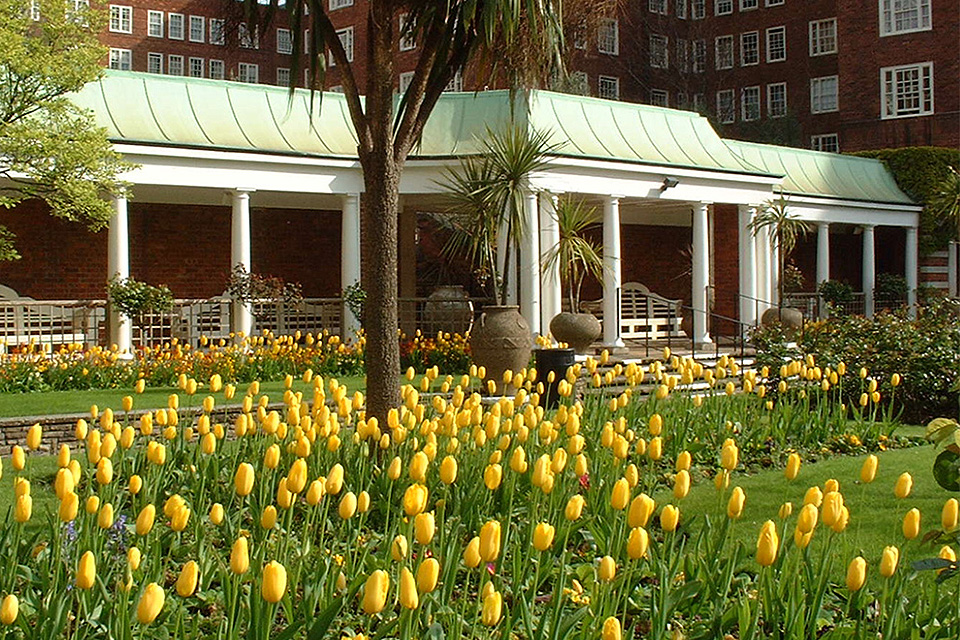
-
Dolphin Square Gardens, London, UK, 2018. Photo by Pamela Preller.
